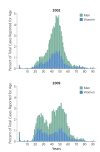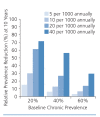The hidden epidemic of hepatitis C virus infection in the United States: occult transmission and burden of disease
- PMID: 23596274
- PMCID: PMC6148892
The hidden epidemic of hepatitis C virus infection in the United States: occult transmission and burden of disease
Abstract
Society faces an immense burden of hepatitis C virus (HCV) infection-related morbidity and mortality. Transmission of HCV is ongoing, and the incidence of HCV infection has been increasing in recent years. New therapies for treating HCV infection hold considerable promise for increasing cure rates and thus reducing HCV transmission. However, many persons with HCV infection in the United States are unaware of their infection status. The Centers for Disease Control and Prevention (CDC) recently expanded its HCV testing recommendations to include 1-time HCV testing for individuals born between 1945 and 1965, a population with a 3% prevalence of infection. Linkage to care and treatment for those identified with infection through testing would have a profound impact in reducing HCV disease burden. Coordinated efforts by public health agencies, clinical care providers, laboratories, and payers are necessary to improve primary and secondary prevention of HCV disease. This article summarizes a presentation by John W. Ward, MD, at the IAS-USA live continuing medical education program held in Atlanta, Georgia, in October 2012.
Conflict of interest statement
Financial Affiliations: Dr Ward has no relevant financial affiliations to disclose. (Updated 3/20/13)
Figures




References
-
- Rein DB, Wittenborn JS, Weinbaum CM, Sabin M, Smith BD, Lesesne SB. Forecasting the morbidity and mortality associated with prevalent cases of pre-cirrhotic chronic hepatitis C in the United States. Dig Liver Dis. 2011;43(1):66-72. - PubMed
-
- Centers for Disease Control and Prevention (CDC). Hepatitis C virus infection among adolescents and young adults:Massachusetts, 2002-2009. MMWR Morb Mortal Wkly Rep. 2011;60(17):537-541. - PubMed
-
- Martin NK, Vickerman P, Foster GR, Hutchinson SJ, Goldberg DJ, Hickman M. Can antiviral therapy for hepatitis C reduce the prevalence of HCV among injecting drug user populations? A modeling analysis of its prevention utility. J Hepatol. 2011;54(6):1137-1144. - PubMed
-
- Perz JF, Grytdal S, Beck S, et al. Case-control study of hepatitis B and hepatitis C in older adults: Do healthcare exposures contribute to burden of new infections? Hepatology. 2013;57(3):917-924. - PubMed
Publication types
MeSH terms
LinkOut - more resources
Full Text Sources
